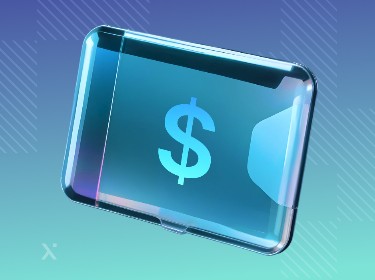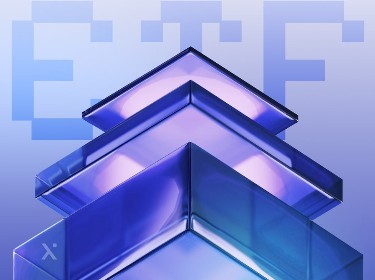Blockchain was once a bold experiment, but today it has evolved into a mature tech that is entering various spheres of life. Businesses and investors now need to keep pace with this innovation to overtake their competitors and stay ahead of the game.
The blockchain was invented in 2008 as a technology to support the Bitcoin cryptocurrency development. In 2018, Bitcoin reached the peak of its popularity, marking a significant point for the recognition of the technology itself.
Now, it has managed to emerge from Bitcoin’s shadow and disrupt numerous industries, including finance, healthcare, supply chain, government, legal, and more. Many of the current use cases aren’t even related to cryptocurrencies. Today, blockchain technology offers practical solutions for both businesses and private individuals, introducing new use cases such as blockchain-as-a-service, digital identities, and asset tokenization.
Read on to learn about the latest trends in blockchain technology that are shaping the future of businesses across the globe.
Key blockchain statistics for 2025 and beyond
Before diving into each blockchain trend, let’s look at facts and statistics showing blockchain growth.
![]()
The biggest blockchain trends to follow in 2025
In 2025, pivotal blockchain trends encompass the ascent of stablecoins, blockchain’s influence on environmental and governance objectives, enterprise blockchain growth, and DeFi’s reshaping of finance. Additionally, the rise of DEXs, STOs, Ethereum’s leadership, digital identities via blockchain, CBDCs, Blockchain-as-a-Service, its role in media and entertainment, and vaccine tracking stand out.
Let’s dig a little deeper into each of these anticipated developments.
![]()
Stablecoins growing and attracting attention
While Bitcoin and Ether are definitely the most attractive and hyped cryptocurrencies, everyone is aware of their one big drawback — they’re extremely volatile. On the one hand, cryptocurrency holders can capitalize on volatility when currency rates rise. On the other, prices can fall dramatically and you can lose a lot of money.
As for stablecoins, the name speaks for itself. It is also a blockchain-based coin, but its value is pegged in a 1:1 ratio to a traditional currency such as dollars or euros. Stablecoins can also be backed by commodities like gold or oil.
Basically, a stablecoin is a hybrid of crypto and fiat currencies that combines the benefits of both digital and real assets. Just like crypto, stablecoin is easy and fast to transfer, and like traditional currencies, its price doesn’t suddenly jump or fall.
At the moment, the largest stablecoins by market cap are Tether USDt ($84.4 billion), USDC ($25 billion), Dai ($5.3 billion), TrueUSD ($3.3 billion), and BUSD ($2 billion). In total, there are about 150 stablecoins.
Given the constant and rapid growth of stablecoins, it is safe to say that this blockchain trend will keep developing and strengthen even more in the coming years.
Blockchain serving environmental, social, and governance goals
Helping countries around the world achieve their environmental, social, and governance goals is one of the blockchain adoption trends in 2025 and beyond.
Blockchain offers solutions that can help energy producers trade electricity without intermediaries and enable governments to run recycling programs. In addition to that, blockchain implementation simplifies supply chain management and traceability and even assists in monitoring, verifying, and reducing carbon emissions.
Let’s see how all these things have become possible.
Energy
Traditionally, power grids are centralized and often don’t allow for efficient energy distribution. The use of a peer-to-peer energy blockchain system helps reduce the need for long-distance transmission and storage of electricity, as those having surplus energy can sell and move it locally. It is an especially good solution for those using renewable energy.
SunContract, for example, is one such platform. This blockchain-based P2P energy trading system offers customers the chance to buy and sell solar and other renewable energy without intermediaries. The main idea behind this marketplace is that electricity should be traded directly between those who produce it and those who consume it.
Recycling
People already consciously recycle various items, but they would be even more motivated if they could get rewarded for it, right? Several blockchain-powered recycling programs encourage people to recycle by rewarding them with cryptographic tokens.
A prominent example is the Plastic Bank project. The project’s team and volunteers set up collection centers in developing countries where people, especially those in need, can collect and donate plastic in exchange for currency, services, or necessary items.
The project utilizes a blockchain-secured platform to meticulously track every kilo of plastic exchanged, ensuring transparency and preventing double-counting through unique claim IDs for transactions. This system not only enhances traceability but also provides partners with custom, data-driven impact dashboards to monitor and share their environmental conservation progress.
Plastic Bank has 40,346 registered members who have helped to recover over 101 million kg of plastic to date.
Check out the HELO blockchain powered by the unique, eco-friendly PoE consensus mechanism
Enterprise blockchain going mainstream
Enterprises are mostly interested in permissioned blockchain because it only allows authorized users, in this case, company employees, to access the network. Permissioned blockchain-based systems also provide an access control function, which means that access to certain documents and information is role-based and customizable.
Companies that choose to turn to enterprise blockchain development to get enhanced security, transparency, workflow automation, and higher efficiency.
A study conducted by Deep Analysis predicts that the total enterprise blockchain technology sales market will grow to $13.2 billion in 2025. This surge reflects the growing recognition among businesses of blockchain’s potential to revolutionize operations, streamline processes, and fortify trust in inter-company collaborations.
DeFi apps transforming traditional finance
![]()
Decentralized finance, or DeFi, is a movement that is currently revolutionizing traditional financial products and services by relocating them to the blockchain.
Among the services, specialists, and products that DeFi is bringing innovation to today are cryptocurrency exchange development companies. One of the most popular forms of DeFi that has gained traction and the main development path in 2025 is building cryptoexchanges and lending platforms. How do they work? A potential lender creates an account on a blockchain platform, where they buy coins and lend them out at interest. As a result, the lender earns money, and the borrower gets easy access to loans.
DeFi also enables millions of people to enter the financial world and become investors, as DeFi products offer barrier-free entry options and thus make markets accessible to a wide range of people from different countries.
Generally, DeFi products give users access to:
- Alternative savings
- Lending and borrowing
- Fast, cheap, and secure payments
- Staking
- Crypto and fiat currency trading
- Affordable insurance
- Asset tokenization and management
Potentially, decentralized financial platforms can outperform banks, because they let users interact directly with each other, without any intermediaries claiming their share.
DEXs getting even more recognizable
Decentralized exchanges (DEXs) are blockchain-powered platforms that allow their users to securely buy and sell cryptocurrency without any third parties.
In 2024, May became the peak month in terms of the volume of crypto transactions on DEXs, with the DEX Trading Volume exceeding $74 billion. The year is not over yet and this number may go even higher.
One of the most prominent decentralized exchanges is Uniswap. This DEX is built on the Ethereum blockchain and enables the swapping of ERC-20 tokens. At the moment, the Uniswap decentralized exchange has 63.7% of the market share.
Decentralized exchanges offer many benefits, such as complete control over funds and private keys, security, privacy, and the ability to trade all kinds of tokens. They also constantly evolve and improve their mechanisms.
Taking into account these facts and statistics, it’s obvious that decentralized exchanges will soon make full entry into the financial world.
Dive even deeper into decentralized exchanges, their pros, cons, and essential features, and see some examples
STOs: tokenization of bonds on the rise
STOs, Security Token Offerings, are not a new phenomenon in the crypto space, but they have received a lot of attention in 2024. As of October 25, the total security token market cap stood at $17,1 billion. Regarding tokenization overall, projections indicate a surge from $2.74 billion in 2022 to $18.50 billion by 2032, marking a remarkable growth trajectory.
STOs represent an efficient and regulated way to invest and raise capital, and all the processes are recorded on the blockchain. Security tokens are cryptographic tokens that are backed by assets like bonds, corporate stocks, real estate, and even cars. They are subject to securities laws and regulations and are considered to be investments.
The popularity of real estate tokenization can also be attributed to the fractional ownership option. One property doesn’t need to be sold as a whole but can be divided into multiple tokens. The issuer can offer these tokens at a lower price, which opens up investment opportunities for a larger number of people and makes typically illiquid assets more attractive.
Blue Karma Secrets Hotels & Resorts in Bali, the Beachfront hotel in Phuket, and the St. Regis Aspen Resort in Aspen, Colorado are just a few of the projects currently running STO campaigns.
May Ethereum be with us
![]()
Ethereum has been a major player in the crypto space since 2015. These days, Ethereum serves as the basis for an enormous number of blockchain projects, platforms, solutions, and tokens. It is also the second-largest cryptocurrency after Bitcoin.
Recent trends in blockchain technology such as asset tokenization and STOs are particularly impacting Ethereum’s popularity, as its ERC-20 and ERC-721 standards are the most actively used protocols for creating tokens. The former allows the issuance of fungible tokens such as voting tokens or digital currencies, while the latter enables non-fungible tokens.
As of October 26, 2023, Ethereum’s daily transactions hit 1.092 million. Meanwhile, its cryptocurrency ETH is valued at $1,786.63, holding a solid market cap of over $214 billion.
Blockchain for secure digital identities
The introduction of digital IDs has been a hot topic for at least five years now. We recently watched blockchain-based digital identity pilots launched in countries like Switzerland, Estonia, and Japan. These days, the creation of eIDs has also become a necessity due to the COVID-19 pandemic, which has caused a massive shift to online services.
A Juniper Research study indicates that the number of eID applications in use will significantly increase to 6.2 billion by 2025. The study has also analyzed what role blockchain will play in the development of digital identity apps. It says that blockchain will be an important tech for the future of eIDs. Moreover, 16% of all third-party identity applications will be blockchain-powered in 2025.
Indeed, blockchain provides secure access to data, transparency, and trust, and makes sure that citizens’ sensitive information is safely stored and shared. So, it is only natural that this technology will impact positively on the entire digital economy, as well as contribute to the creation of digital identities.
Check out Blockcerts – a secure blockchain platform that makes it easy to issue, share and receive official credentials
Rising interest in Central Bank Digital Currencies (CBDCs)
The concept of Central Bank Digital Currency (CBDC) was proposed a decade ago. But, as often happens with cool inventions, real fame only came to CBDC a while later.
In simple terms, a central bank digital currency is the fiat currency of a specific country in digital form. CBDC is usually powered by the blockchain, but unlike cryptocurrencies, it is regulated and backed by a central authority — the country’s central bank.
This phenomenon is still in its infancy. A survey by the Bank for International Settlements has found that 86% of central banks are actively researching the potential, benefits, and drawbacks of CBDC, 60% are already experimenting with the concept, and 14% are planning to launch pilots. England, China, Canada, Sweden, Thailand, and Uruguay are also among the countries looking to try out the CBDC concept.
Blockchain-as-a-Service
Blockchain-as-a-Service, or BaaS, is an easy-to-use cloud service for designing, and later managing, smart contracts and decentralized applications with blockchain technology. BaaS is currently utilized by established businesses of various sizes as well as startups.
Many world-renowned companies such as Microsoft, IBM, Amazon, Alibaba, and SalesForce now provide Blockchain-as-a-Service. It enables enterprises to access the software, leverage the technology, and make the most out of it without the huge upfront financial and time investment needed to develop their own infrastructure and learn new skills.
Blockchain for vaccine tracking and distribution
![]()
The successful development of COVID-19 vaccines has become the light at the end of the tunnel for people around the world. The next challenge for governments — safe and effective vaccine distribution to the public.
On the whole, blockchain in supply chain management has proven to be a great tool as it brings transparency, accountability, enhanced security, and trust to the process. As for vaccine distribution in particular, there are several successful real-life use cases. For example, one of the first such initiatives in the world was launched in the UK. Here, two hospitals are utilizing blockchain to track and monitor the storage and supply of temperature-sensitive COVID-19 vaccines.
“We can absolutely verify the data that we’ve collected from every single device. We make sure that data is accurate at source, and after that point, we can verify that it’s never been changed, it’s never been tampered with,” said Tom Screen from Everyware, a company that monitors vaccines and other treatments for the NHS.
Blockchain helps these healthcare facilities provide safe patient care as well as speed up the vaccination process, thereby contributing to overall victory over the virus.
Although the world appears to have moved on from the pandemic, the application of blockchain technology in this area won’t stop. The tech will be applied to track the delivery of other vaccines, drugs, and medical equipment.
Blockchain transforming media and entertainment
Statistics show that as of July 2021, there are 4.48 billion active social media users around the world, which is around 57% of the global population. Almost all of us use platforms like Facebook, Instagram, and TikTok. They are free to use and offer exciting features, but they are also centralized systems that store, censor, and share our data. If there are any security breaches, our accounts may be compromised.
Decentralized blockchain-powered solutions come to the rescue. Blockchain has the potential to address pressing social media problems such as lack of user control over their data, data security concerns, and “floods” of ads. By using blockchain, users can track where their information goes and how it’s used, capitalize on their work and content, and get rid of irritating ads, as a blockchain social network has no central owner who would decide what the user sees and when.
An interesting example of a blockchain social network is Steemit which is essentially a decentralized blogging platform. Another promising project, Minds, offers a decentralized social media platform that rewards users with tokens for creating and sharing quality content and participating in various activities.
Click here and get answers to all your questions about blockchain social media
To sum up
We could actually go on and on listing blockchain trends as the number of blockchain use cases and platforms grows by leaps and bounds every year. Nowadays, ideas like using blockchain for social media, vaccine distribution, central bank digital currencies, digital identity, and even environmental protection are no longer theoretical but have become reality.
It’s the year 2025, and we can leverage blockchain technology to secure personal information, customize access to it, tokenize any kind of assets, and boost company performance and revenue. Soon we will probably stop talking about blockchain as a new and revolutionary technology because it will have become the standard.
However, these days, blockchain project implementation is still a complex task. You will need to partner with a custom blockchain development company that has a solid portfolio of successful projects. Blockchain professionals will help you understand all the aspects of this technology, evaluate its benefits and drawbacks, and offer a solution tailored to your business case.
Don’t get left behind — embark on your blockchain journey today with our blockchain consulting services!




